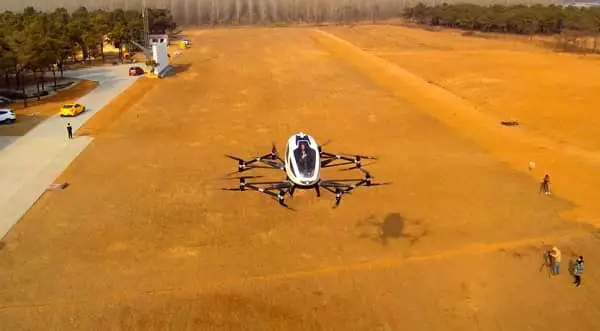
Drones are amazing machines that are capable of many things, but would you ever think this includes carrying a human being? Well, I did some research and here’s what I found.
Some companies have now begun to develop drones that are large enough to actually carry a human being, as well as transport them from one point to another. Here they are.
| Drone Name: | Flight Time: | Range: | Weight Capacity: | Price: | Link: | |
| 01. | Griff 300 | 45 min | 9 miles | 500lbs | $250,000 | VIEW |
| 02. | Ehang 184 | 23 min | 9.5 miles | 550lbs | $280,000 | VIEW |
| 03. | Volocopter 2X | 27 min | 16.5 miles | 440lbs | $250,000 | VIEW |
Keep reading if you want to find out more about these industry-breaking drones and how they could possibly change the world one day!
The Griff 300
Griff Aviation designs drones that are meant to be the best in the industry, leading in quality, performance, and mission flexibility. Their Unmanned Aerial Systems(UAS) have a wide range of payload options that are able to be used for professional use.
These state-of-the-art payload options are fully customizable and can be designed specifically for any Armed Forces, Law Enforcement, Fire Services, and Rescue teams.
Let’s take a closer look at some of the features:
- Range: The range for this drone is 9 miles.
- Endurance: The Griff 300 has about 45 minutes of airtime depending on what it is carrying.
- Capacity: The Griff 300 can carry about 500 pounds(226kg) of payload weight.
- Cost: The UAV will be priced at around $250,000 but this price is not the final price. The final price depends on the client’s requirements.
- Speed: The Griff 300 has a maximum speed of 37mph.
This Norwegian company takes great pride in its new drone! With the capability to lift 500 pounds and with a flight time of 30 minutes, it is able to carry a person to any location within its 9-mile range limit.
This drone was not actually designed to carry people, instead, it was designed to carry large payloads to assist emergency services and the likes. Even so, the Griff 300 is able to easily carry the weight of up to 3 human beings! Amazing, right?
The Ehang 184
The Ehang 184 had its debut in 2016 and since then has been the centre of attention in the eyes of global media and the general public.
As a tech startup and the pioneer of the Air Taxi industry, Ehang has been able to bring the world closer to the dream everyone has been hoping for since watching the Jetsons zip around in their flying family car.
Let’s take a look at some of the features:
- Range: The Ehang 184 has a range of about 9.5 miles.
- Capacity: This drone was only designed to carry one person.
- Cost: The Ehang 184 drone will cost you between $200,000 and $300,000.
- Cruise Speed: 81 mph(130 km/h)
The Ehang 184 is a fully automated drone which means it can transport its passenger from point A to point B without the need for the passenger to manually take control of the vehicle.
Ehang has plans to build the worlds first Airport for Air Taxis in Guangxi which is a huge step forward for Self-Flying Vehicles. The Ehang 184 is more than a drone, it is more like a sky Tesla in terms of capabilities!
At the speed the Ehang will be flying at, within its 9.5-mile range, of course, the vehicle will get you there in no time!
The Volocopter 2X
The Volocopter 2X is a German two-seat multi-rotor electric helicopter. The vehicle was designed by Volocopter GmbH and was introduced back in 2017 at the AERO Friedrichshafen airshow. The aircraft was actually designed to comply with the European Class 6 microlight helicopter rules and be registered as an Air Taxi!
The Volocopter is made from carbon fiber composites and is an optionally-piloted multi-rotor electric helicopter.
Let’s take a look at some of the features:
- Range: It has a range of 16.5 miles.
- Endurance: The Volocopter can last for about 27 minutes of consistent flight. This is obviously not taking into account different weather changes; the weight it is carrying and other factors. So, the flight time may vary.
- Top Speed: You should not be planning on flying too fast, but the Volocopter has a top speed of about 62mph(100km/h).
- Engine Type: Brushless electric motor.
- Carry Limit: The Volocopter 2X can carry up to 440 pounds(199kg) which is around the weight of 3 human beings of average weight, but it is only allowed to carry one human at a time.
- Cost: With the basic specs, the Volocopter 2X would cost you about $250,000, which is not simply pocket-change for most people. However, considering that you would never have to sit in traffic again, this may be a worthy investment!
The Volocopter has a carrying capacity of just one person as it is a one-seater. This is another big step forward for the Air Taxi industry, as it means we are just one step closer to being able to create transportation devices that will allow us to go from one place to another, and possibly even self-pilot!
For some interesting visuals, check out this video demonstrating real footage of people being carried by drones:
The Legality Behind Carrying People Inside Drones
Regular drones come in all shapes and sizes as well as many different prices. The higher-end drones are generally less accessible to the public because of their price. For many people, it will take years to be able to afford these new machines but the price tag of these drones is not even the biggest problem.
The biggest problem with passenger drones is that they are actually banned in most countries at the moment. They will most likely be completely automated when introduced for many reasons, but mainly because of safety and how hard it is to get a pilots’ license.
The type of drone needed to carry a human being would need to be fairly large in size, with more motors than your average drone. Therefore, the person flying the drone also needs to be a skilled pilot or the drone needs to be automated to reduce human error.
From my list, the only drone that you can fly without a license is the Ehang 184.
It is currently unknown where we are with the authorities in terms of allowing for these drones to be accessible and used in today’s world, but the Ehang 184 has conducted numerous fully automated flights successfully.
The Science Behind Passenger Drones
There is a lot of things that affect whether or not a drone is able to take off or not with a large capacity, many of which may surprise you! Here are some of the factors that influence this incredible technological advancement:
Size: The size of the drone has a big part to play when it comes to whether or not it will be able to take off. The drone needs to be big in order to be able to carry a human being or two and the bigger the drone the heavier it will be! This means it will naturally require more power to be able to get it off the ground.
Motor Power: The motor is the key to getting the drone off the ground. The motor is what drives the propellers to turn and that is what causes the drone to lift. When the drone is bigger than normal, the motors will need to be bigger and more powerful as well.
Propeller Size: The size of the propellers on the drone is important because they need to be proportional to the size of the drone itself. The general rule of thumb is that the propeller thrust should be twice the size of the drone.
Battery: The bigger the drone the more power you need to be able to lift it, and the motors will be much larger, therefore, needing a bigger battery to power them.
Final Thoughts
It truly is incredible that we are now able to carry human beings in self-piloted drones! It almost seems as if we are entering the new space-age. With some exciting innovations underway and new technology developing rapidly, we can only anticipate what new advancements will soon be a part of our daily lives!
